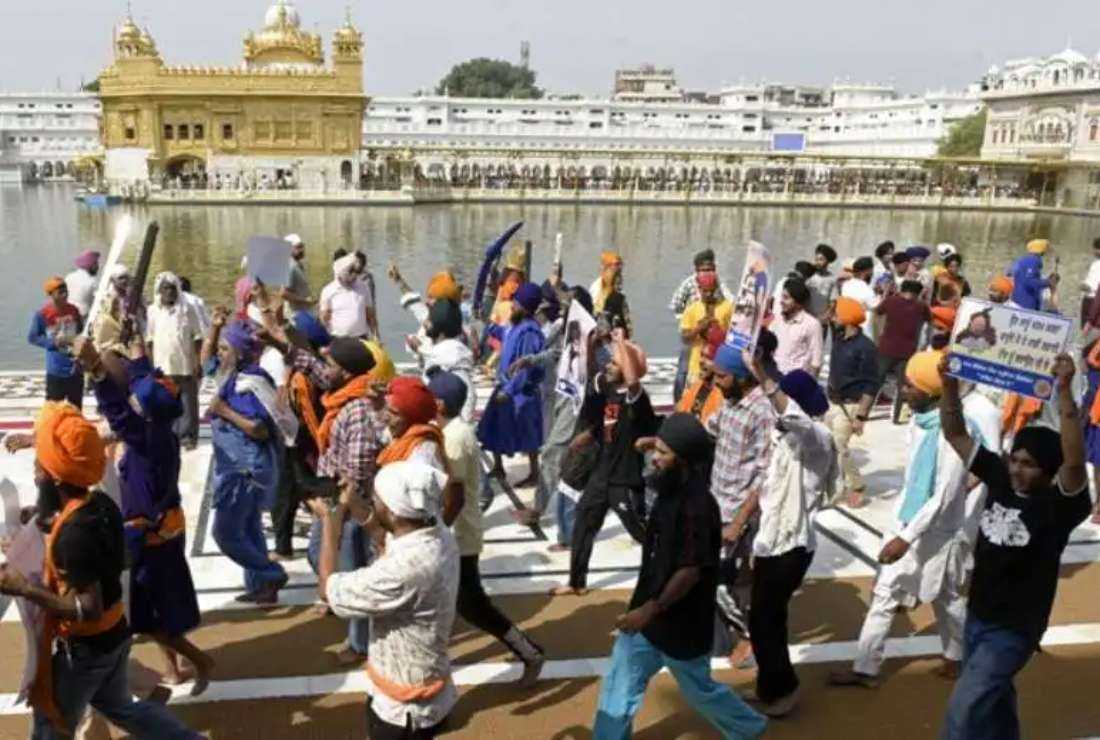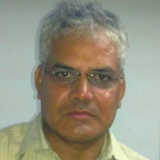Indian authorities need to tread carefully as crisis brews in the land of the brave, proud and loyal Sikhs

Activists from Sikh organizations shout slogans after offering prayers at the Golden Temple on the 38th anniversary of Operation Blue Star in Amritsar on June 6, 2022. (Photo: AFP/ UCAN files)
The specter of Khalistan, a separate Sikh homeland, seems to have returned to haunt the people of the northern Indian state of Punjab.
The idea of a sovereign state based on the Sikh religion, simmering since India’s independence in 1947, has remained a pipe dream for a section of disgruntled fringe elements without any popular support.
Its new poster boy, Amritpal Singh, a radical Sikh preacher who has been attempting to reignite the separatist movement in recent months is currently on the run while an uneasy quiet prevails in Punjab.
Until the radical preacher returned from Dubai in August 2022, most people thought that the idea of Khalistan was dead in Punjab state.
But the intriguing and youthful Singh, who proclaims himself to be the chief of a Khalistani pressure group Waris Panjab De, or Heirs of Punjab, seems to have single-handedly whipped up sentiments, exposing the ineptness of both the current state government led by the Aam Aadmi Party (AAP) and the federal intelligence agencies.
“Indian agencies claim he has links with known terrorists smuggling narcotics and arms into the country”
It is being claimed that Singh is “a plant” by Pakistan intelligence agencies to muddy the waters in Punjab. However, the authorities must answer how they miserably failed to take timely action against him and mysteriously allowed him to flee.
Singh appeared in Punjab from virtually nowhere and took the state by storm by projecting himself as a fighter for Sikh pride.
Interestingly, during the initial days after landing in his village near Amritsar, where the Golden Temple, the holiest religious complex of the Sikh religion is located, he began by projecting himself as an anti-drugs crusader.
This is curious since Indian agencies claim he has links with known terrorists smuggling narcotics and arms into the country. Question is, if this was already known, why no action was taken against him?
Singh would openly threaten the police and challenge the pro-Hindu Bhartiya Janata Party (BJP) by drawing a parallel between its Hindu Rastra, or nation for Hindus, to his pipe dream of a Sikh homeland.
His aggressive utterances and antics clearly helped to revive bitter memories of militancy in Punjab that led to Operation Blue Star being carried out by the Indian army to flush out militants from the Golden Temple in June 1984, and the assassination of then Prime Minister Indira Gandhi by her own Sikh bodyguards that year on Oct. 31 followed by the worst anti-Sikh riots in capital Delhi and several others parts of the country.
The aggrieved Sikh community has been waiting ever since for a healing touch.
Singh, in true sectarian style, is prone to provocative language, saying “Punjab is for Punjabis,” and has also been threatening evangelical Christian groups with dire consequences if they convert gullible people in the state.
“What is happening in Punjab is nothing but a diversion tactic by the incumbent government to cover up its failures”
He made no bones about his intentions when he incited his men to take the law into their hands and surround a police station when a close aide of his Lovpreet Toofan was arrested recently.
Singh came to be referred to as “Bhindranwale 2.0” drawing comparisons with Jarnail Singh Bhindranwale, the militant leader of Sikh separatists who was killed in Operation Bluestar and proclaimed a martyr by them.
Before returning to India, Singh was based in Dubai where he engaged in a relative’s transport business. Influenced by the Western lifestyle, he did not even wear a turban and was active on social media.
How the sudden transformation in 2022 came about remains an intriguing matter although Sikh separatists have a history of operating from foreign soil, especially in the West.
Back home in the state, many like Gurameet Singh, a prominent farmer leader, feel the Khalistan movement does not enjoy any support among native Sikhs and see a political design behind the rise of a hitherto unknown face.
“What is happening in Punjab is nothing but a diversion tactic by the incumbent government to cover up its failures. It’s a well-planned design that cannot take shape without state sponsorship,” he believes.
Who let it happen? That seems a pertinent question writ large on the face of thinking people in Punjab even as the Amritpal Singh episode continues to unfold.
Perhaps it could culminate in the upcoming by-election in the Jalandhar parliamentary seat, where the majority of voters are Hindu. Both AAP and BJP could hype up Khalistan to gain Hindu votes in the name of nationalism. Social media is rife with such political speculations.
“Both the federal and state governments have done little to provide relief to the population in Punjab”
Unfortunately, this could lead to unnecessary vilification of the native Sikhs who clearly aren’t clamoring for Khalistan — there weren’t any protests following the arrest of over 150 youths, associated with the now absconding self-styled leader of the movement.
Everything is normal in Punjab except for the state brutalities. A glaring example is the arrest of a lawyer for preparing a list of youth arrested by the police claiming an association with Singh.
Police from eight districts are hunting for the radical Sikh preacher and should explain how he’s managed to escape and remain elusive all these days. Instead, the authorities have clamped down with a mobile internet blackout across the state of about 30 million people.
Why the different yardsticks for Sikh nationalists and Hindu nationalists?
Both the federal and state governments have done little to provide relief to the population in Punjab facing serious issues related to agriculture, employment, and the incidence of high drug abuse among its dejected youth.
Sikhs are not Hindus but are often being told they are, and additionally, the Hindi language is being imposed on the native Punjabi speakers.
It appears as if the ground was laid for the rise of someone like Amritpal Singh. Thankfully, only a very small section of people seem to have been swayed by his glib talk so far.
People of Punjab refuse to see another radical preacher as their Messiah but the governments of the day seem bent on playing with fire.
The only likely end consequence of it all will be that the brave, proud and loyal Sikhs will end up hurt yet again. Whether it was the freedom struggle or wars with its neighbors since independence, the Sikh community’s contribution has been disproportionately large relative to the small size of its population.
Indian authorities need to deal with the current crisis in Punjab with sensitivity.
*The views expressed in this article are those of the author and do not necessarily reflect the official editorial position of UCA News.

